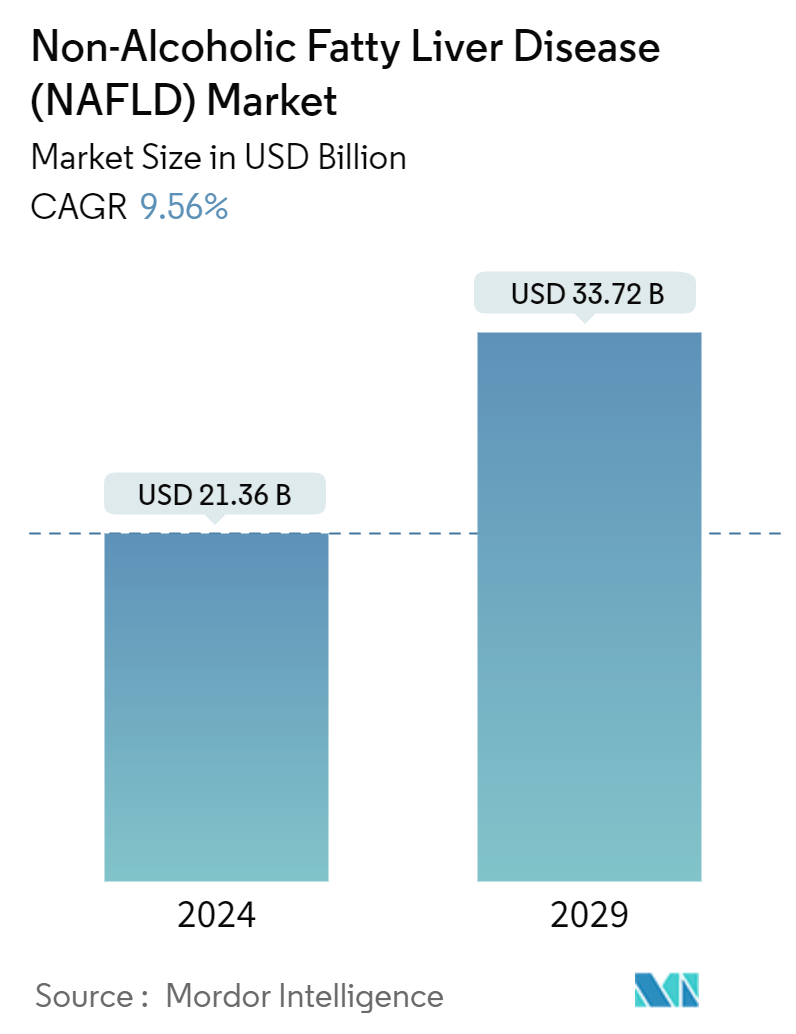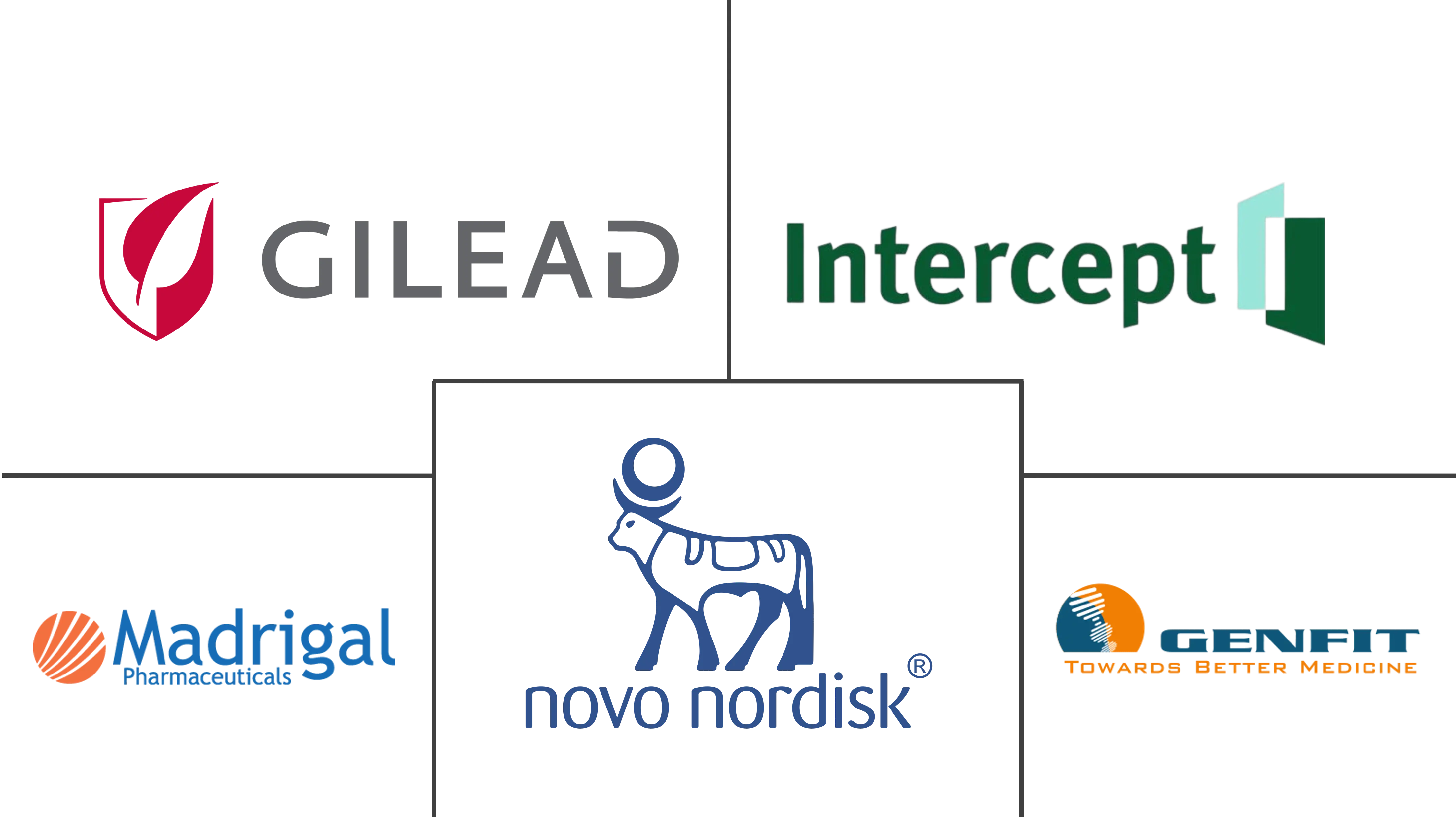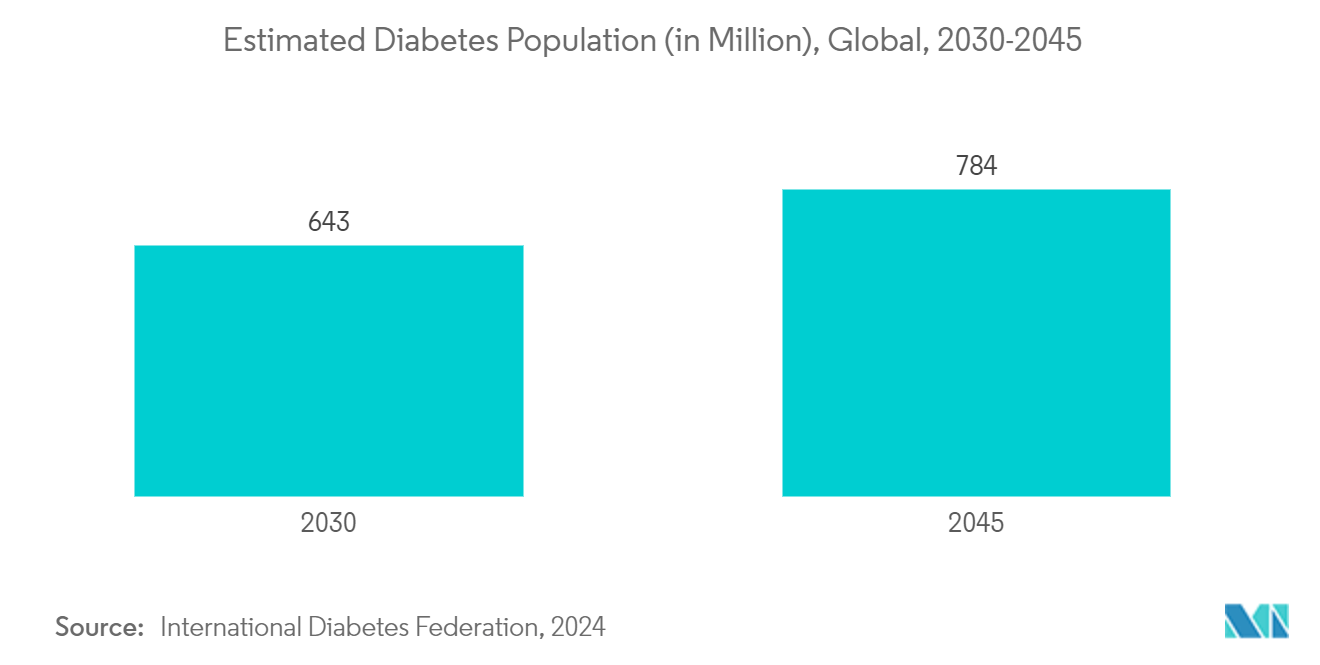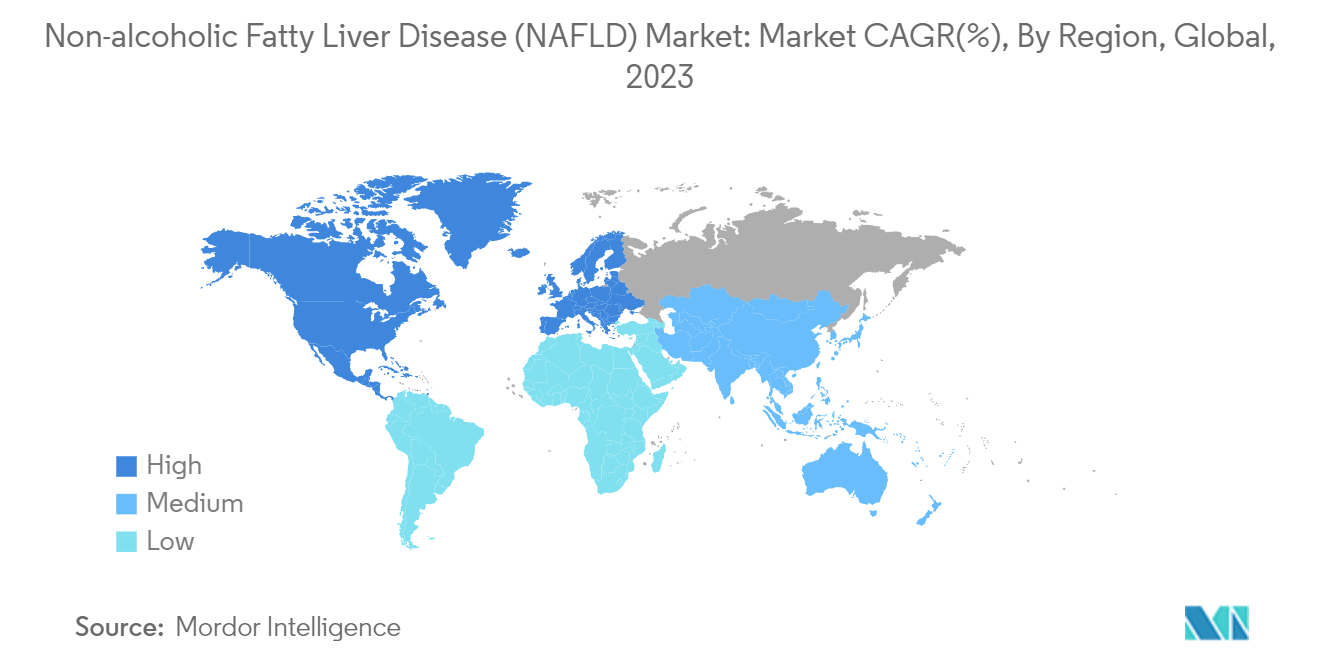Non-Alcoholic Fatty Liver Disease (NAFLD) Market Size

| Study Period | 2019 - 2029 |
| Market Size (2024) | USD 21.36 Billion |
| Market Size (2029) | USD 33.72 Billion |
| CAGR (2024 - 2029) | 9.56 % |
| Fastest Growing Market | Asia Pacific |
| Largest Market | North America |
Major Players
*Disclaimer: Major Players sorted in no particular order |
Non-Alcoholic Fatty Liver Disease (NAFLD) Market Analysis
The Non-Alcoholic Fatty Liver Disease Market size is estimated at USD 21.36 billion in 2024, and is expected to reach USD 33.72 billion by 2029, growing at a CAGR of 9.56% during the forecast period (2024-2029).
Factors such as the increasing burden of non-alcoholic fatty liver disease, the rising global prevalence of diabetic and obese populations, and increasing awareness about NAFLD are expected to boost the growth of the non-alcoholic fatty liver disease (NAFLD) market during the forecast period.
As global rates of obesity, type 2 diabetes, and metabolic syndrome rise, the prevalence of non-alcoholic fatty liver disease (NAFLD) is increasing. This surge in NAFLD cases is driving up the demand for effective and safe drugs, fueling the market's growth. For instance, the data published by the UK Government on Liver Disease in April 2024 highlights a concerning trend: hospital admissions for liver diseases in the United Kingdom are on the upswing. Specifically, in FY2023, the admission rate climbed to 155.2 per 100,000 population, up from 150.6 the year prior. Given the increase in NAFLD-related hospital admissions, there is a heightened emphasis on early treatment, which is expected to boost the market's growth in the coming years.
Type 2 diabetes significantly heightens the risk of NAFLD progressing to fibrosis, necessitating liver transplants and even leading to mortality. For instance, data from the International Diabetes Federation, updated in 2024, forecasts that 643 million individuals worldwide will be affected by diabetes by 2030, with the figure surging to 784 million by 2045. This anticipated rise in the diabetic population amplifies their susceptibility to NAFLD, underscoring the urgent need for NAFLD screenings among diabetic patients. Consequently, this demand is poised to drive the growth of the market for novel drugs.
Globally, rising obesity rates and metabolic disorders, driven by lifestyle changes, are leading to significant health challenges and costly treatments. This scenario underscores the urgent need for effective treatment, further fueling market expansion. For instance, the World Obesity Atlas 2023 projects that the prevalence of obesity (defined as a BMI ≥30kg/m²) is expected to surge from 14% to 24% between 2020 and 2035. By 2035, nearly 2 billion individuals, spanning adults, children, and adolescents, are expected to be affected. Obesity results in excessive fat accumulation in various tissues, notably the liver, a primary factor contributing to NAFLD. Such dynamics intensify the demand for novel drugs, driving the market's growth.
Therefore, the growing burden of NAFLD, obesity, and type 2 diabetes among the population coupled with new product approvals, the studied market is expected to grow during the forecast period. However, the lack of approved drugs for non-alcoholic fatty liver disease (NAFLD) and slow advancements in the therapeutic field are likely to hinder the market's growth during the forecast period.
Non-Alcoholic Fatty Liver Disease (NAFLD) Market Trends
The Fibrosis Treatment Agents Segment is Expected to Witness Significant Growth During the Forecast Period
Fibrosis treatment agents are used for the treatment of non-alcoholic steatohepatitis (NASH), a severe form of non-alcoholic fatty liver disease (NAFLD), characterized by liver inflammation and damage caused by a buildup of fat in the liver, and hypertriglyceridemia. Factors such as the rising prevalence of NASH, the rising rate of obesity and type 2 diabetes, and the increasing number of research studies evaluating the effectiveness of using anti-fibrotic agents in treating NAFLD are expected to boost the segment's growth during the forecast period.
Due to the high prevalence and severe complications associated with NASH, there has been a concerted effort to develop effective treatments. For instance, data from the Global Liver Institute, published in June 2023, projected that by 2030, approximately 357 million individuals will be affected by NASH. Consequently, this anticipated surge in NASH patients increases their risk of developing fibrosis, which amplifies the demand for effective drugs, intensifying the market's need for innovative drugs and driving the segment's growth.
Various studies were conducted to identify potential drugs for the treatment of patients with non-alcoholic fatty liver diseases. For instance, according to an article published in the New England Journal of Medicine, in June 2023, researchers at the University of California San Diego School of Medicine discovered a promising drug, Pegozafermin, for treating non-alcoholic steatohepatitis (NASH). The study highlighted that Pegozafermin mimics fibroblast growth factor 21 (FGF21), a naturally occurring liver-secreted peptide hormone.
In addition to the above context, FGF21 plays a crucial role in the body, regulating energy use, lipid metabolism in the liver, and managing blood glucose and insulin levels. These functions contribute to reducing body weight and liver fat. The study revealed that Pegozafermin leads to improvement in fibrosis and alleviates inflammation and liver injury. Furthermore, it shows marked improvements in various non-invasive biomarkers associated with NASH activity and scarring. Given these findings, the demand for Pegozafermin in the market is expected to surge, driving the segment's growth.
Therefore, owing to the rising development of novel drugs by researchers and the increasing strategic initiatives by companies to fuel the availability of novel drugs in the market, the studied segment is expected to grow during the forecast period.

North America is Expected to Hold a Significant Share in the Market During the Forecast Period
North America is expected to witness significant growth in the market during the forecast period owing to factors such as the rising prevalence of non-alcoholic fatty liver disease, the increasing burden of obesity and type 2 diabetes among the population, growing awareness about NAFLD and its potential progression to NASH, increasing public health campaigns and programs, and activities of key players in the region.
The rising prevalence of non-alcoholic fatty liver disease (NAFLD) is a primary driver of market growth in the region. For instance, data from UC San Diego Health published in August 2023 revealed that around 24% of adults in the United States are affected by NAFLD. This statistic underscores the heightened demand for therapeutics, further propelling the market's growth.
Moreover, the surging rates of obesity and diabetes, key risk factors for NAFLD, are concerning. For instance, data from the Government of Canada in March 2023 highlighted that nearly two-thirds of Canadian adults and one-third of children and youth are either overweight or obese. Similarly, the World Obesity Atlas in March 2023 projected a significant 2.1% annual rise in adult obesity rates in Mexico from 2020 to 2035. Additionally, the forecasted annual increase in childhood obesity in Mexico stands at a notable 3.3% for the same period. As cases of obesity and diabetes escalate, the demand for timely NAFLD treatment increases, suggesting a robust market growth trajectory in the coming years.
Government funding activities are accelerating the development of innovative drugs for treating NAFLD conditions, which is projected to drive the market's growth during the forecast period. For instance, data from UC San Diego reveals that in August 2023, researchers at the UC San Diego NAFLD Research Center, part of the University of California San Diego School of Medicine, received a grant of approximately USD 9.57 million. This funding aims to support a clinical trial exploring a new treatment option for patients with the disease.
Moreover, an increase in product launches and approvals from regulatory bodies is set to enhance the market's product availability, further propelling market growth in the coming years. For instance, in March 2024, the United States Food and Drug Administration approved resmetirom (Rezdiffra) for adults suffering from NASH (non-alcoholic steatohepatitis) and experiencing moderate to advanced liver scarring.
Therefore, with the rising burden of non-alcoholic fatty liver disease coupled with increasing risk factors such as obesity and diabetes, growing government funding initiatives, and new product approvals, the studied market is expected to grow during the forecast period.

Non-Alcoholic Fatty Liver Disease (NAFLD) Industry Overview
The non-alcoholic fatty liver disease market is consolidated in terms of ongoing research and development and pharmaceutical pipeline development. The pharmaceutical landscape for NAFLD is dominated by companies that are heavily investing in developing therapeutics for the condition. Some of the key players are Intercept Pharmaceuticals, Madrigal Pharmaceuticals, Gilead Sciences Inc., AbbVie Inc., and Novo Nordisk AS.
Non-Alcoholic Fatty Liver Disease (NAFLD) Market Leaders
-
Intercept Pharmaceuticals
-
Madrigal Pharmaceuticals
-
Novo Nordisk A/S
-
Gilead Sciences, Inc.
-
AbbVie, Inc.
*Disclaimer: Major Players sorted in no particular order

Non-Alcoholic Fatty Liver Disease (NAFLD) Market News
- June 2024: Eli Lilly and Company presented positive results from SYNERGY-NASH, a phase 2 study of 190 patients, with or without type 2 diabetes, at the European Association for the Study of the Liver (EASL) Congress 2024 to evaluate the investigational use of tirzepatide in adults with biopsy-proven metabolic dysfunction-associated steatohepatitis (MASH) with stage 2 or 3 fibrosis.
- March 2024: Ionis Pharmaceuticals Inc. reported positive results from a Phase 2 study of ION224, an investigational DGAT2 antisense inhibitor with both doses (120 mg and 90 mg) in development for the treatment of metabolic dysfunction-associated steatohepatitis (MASH).
Non-Alcoholic Fatty Liver Disease (NAFLD) Market Report - Table of Contents
1. INTRODUCTION
- 1.1 Study Assumptions and Market Definition
- 1.2 Scope of the Study
2. RESEARCH METHODOLOGY
3. EXECUTIVE SUMMARY
4. MARKET DYNAMICS
- 4.1 Market Overview
-
4.2 Market Drivers
- 4.2.1 Increasing Burden of Non-alcoholic Fatty Liver Disease
- 4.2.2 Rising Global Prevalence of Diabetic and Obese Populations
- 4.2.3 Increasing Awareness about NAFLD
-
4.3 Market Restraints
- 4.3.1 Lack of Approved Drugs for Non-alcoholic Fatty Liver Disease (NAFLD)
- 4.3.2 Slow Advancements in the Therapeutic Field
-
4.4 Porter's Five Forces Analysis
- 4.4.1 Threat of New Entrants
- 4.4.2 Bargaining Power of Buyers/Consumers
- 4.4.3 Bargaining Power of Suppliers
- 4.4.4 Threat of Substitute Products
- 4.4.5 Intensity of Competitive Rivalry
5. MARKET SEGMENTATION
-
5.1 By Drug Class
- 5.1.1 Antioxidants
- 5.1.2 Lipid Lowering Agents
- 5.1.3 Thiazolidinedione
- 5.1.4 FXR Receptor Agonists
- 5.1.5 Fibrosis Treatment Agents
- 5.1.6 Biguanides
- 5.1.7 Other Drug Classes
-
5.2 By Distribution Channel
- 5.2.1 Hospital Pharmacies
- 5.2.2 Retail Pharmacies
- 5.2.3 Online Pharmacies
- 5.2.4 Other Distribution Channels
-
5.3 Geography
- 5.3.1 North America
- 5.3.1.1 United States
- 5.3.1.2 Canada
- 5.3.1.3 Mexico
- 5.3.2 Europe
- 5.3.2.1 Germany
- 5.3.2.2 United Kingdom
- 5.3.2.3 France
- 5.3.2.4 Italy
- 5.3.2.5 Spain
- 5.3.2.6 Rest of Europe
- 5.3.3 Asia-Pacific
- 5.3.3.1 China
- 5.3.3.2 Japan
- 5.3.3.3 India
- 5.3.3.4 Australia
- 5.3.3.5 South Korea
- 5.3.3.6 Rest of Asia-Pacific
- 5.3.4 Middle East and Africa
- 5.3.4.1 GCC
- 5.3.4.2 South Africa
- 5.3.4.3 Rest of Middle East and Africa
- 5.3.5 South America
- 5.3.5.1 Brazil
- 5.3.5.2 Argentina
- 5.3.5.3 Rest of South America
6. COMPETITIVE LANDSCAPE
-
6.1 Company Profiles
- 6.1.1 Abbvie Inc.
- 6.1.2 Madgril Pharmaceuticals
- 6.1.3 Novartis AG
- 6.1.4 Exalenz Bioscience Ltd
- 6.1.5 Intercept Pharmaceuticals Inc.
- 6.1.6 Gilead Sciences Inc.
- 6.1.7 Novo Nordisk AS
- 6.1.8 Merck & Co.
- 6.1.9 Zydus Cadila
- 6.1.10 OWL Metabolomics
- *List Not Exhaustive
7. MARKET OPPORTUNITIES AND FUTURE TRENDS
** Subject To AvailablityNon-Alcoholic Fatty Liver Disease (NAFLD) Industry Segmentation
As per the scope of the report, non-alcoholic fatty liver disease is a condition characterized by the accumulation of excess fat in the liver of people. This is caused due to the growing burden of obesity, type 2 diabetes, metabolic syndrome, sedentary lifestyle, and genetic factors.
The non-alcoholic fatty liver disease is segmented into drug class, distribution channel, and geography. By drug class, the market is segmented into antioxidants, lipid lipid-lowering agents, fibrosis treatment agents, thiazolidinedione, FXR receptor agonists, biguanides, and other drug classes. By distribution channel, the market is segmented into hospital pharmacies, retail pharmacies, online pharmacies, and other distribution channels. By geography, the market is divided into North America, Europe, Asia-Pacific, Middle East and Africa, and South America. For each segment, the market sizing and forecasts were done based on the value (USD).
| By Drug Class | Antioxidants | |
| Lipid Lowering Agents | ||
| Thiazolidinedione | ||
| FXR Receptor Agonists | ||
| Fibrosis Treatment Agents | ||
| Biguanides | ||
| Other Drug Classes | ||
| By Distribution Channel | Hospital Pharmacies | |
| Retail Pharmacies | ||
| Online Pharmacies | ||
| Other Distribution Channels | ||
| Geography | North America | United States |
| Canada | ||
| Mexico | ||
| Geography | Europe | Germany |
| United Kingdom | ||
| France | ||
| Italy | ||
| Spain | ||
| Rest of Europe | ||
| Geography | Asia-Pacific | China |
| Japan | ||
| India | ||
| Australia | ||
| South Korea | ||
| Rest of Asia-Pacific | ||
| Geography | Middle East and Africa | GCC |
| South Africa | ||
| Rest of Middle East and Africa | ||
| Geography | South America | Brazil |
| Argentina | ||
| Rest of South America |
Non-Alcoholic Fatty Liver Disease (NAFLD) Market Research FAQs
How big is the Non-Alcoholic Fatty Liver Disease Market?
The Non-Alcoholic Fatty Liver Disease Market size is expected to reach USD 21.36 billion in 2024 and grow at a CAGR of 9.56% to reach USD 33.72 billion by 2029.
What is the current Non-Alcoholic Fatty Liver Disease Market size?
In 2024, the Non-Alcoholic Fatty Liver Disease Market size is expected to reach USD 21.36 billion.
Who are the key players in Non-Alcoholic Fatty Liver Disease Market?
Intercept Pharmaceuticals, Madrigal Pharmaceuticals, Novo Nordisk A/S, Gilead Sciences, Inc. and AbbVie, Inc. are the major companies operating in the Non-Alcoholic Fatty Liver Disease Market.
Which is the fastest growing region in Non-Alcoholic Fatty Liver Disease Market?
Asia Pacific is estimated to grow at the highest CAGR over the forecast period (2024-2029).
Which region has the biggest share in Non-Alcoholic Fatty Liver Disease Market?
In 2024, the North America accounts for the largest market share in Non-Alcoholic Fatty Liver Disease Market.
What years does this Non-Alcoholic Fatty Liver Disease Market cover, and what was the market size in 2023?
In 2023, the Non-Alcoholic Fatty Liver Disease Market size was estimated at USD 19.32 billion. The report covers the Non-Alcoholic Fatty Liver Disease Market historical market size for years: 2019, 2020, 2021, 2022 and 2023. The report also forecasts the Non-Alcoholic Fatty Liver Disease Market size for years: 2024, 2025, 2026, 2027, 2028 and 2029.
Non-Alcoholic Fatty Liver Disease (NAFLD) Industry Report
Statistics for the 2024 Non-Alcoholic Fatty Liver Disease (NAFLD) market share, size and revenue growth rate, created by Mordor Intelligence™ Industry Reports. Non-Alcoholic Fatty Liver Disease (NAFLD) analysis includes a market forecast outlook for 2024 to 2029 and historical overview. Get a sample of this industry analysis as a free report PDF download.



